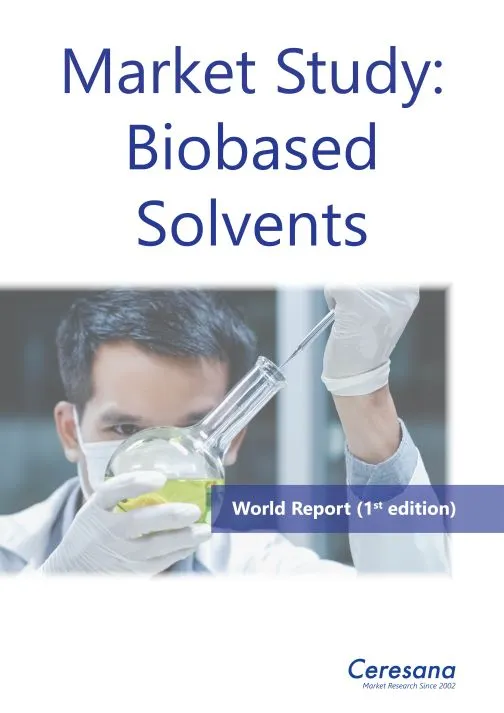Water is the best solvent, but it can’t do everything. Whether it’s liquefying acrylic paints, removing nail polish or even removing asphalt residue, strong chemicals are often needed. Increasingly, industrial solvents are no longer made only from coal, crude oil or natural gas, but from renewable raw materials. To reduce the ecological footprint, biogenic components are also increasingly being added to conventional petrochemical solvents. Ceresana’s new market report „Biobased Solvents“ forecasts that the production volume of biosolvents will increase significantly: Analysts expect annual growth of 3.4% worldwide, and more than 5% in Asia. Sales generated with biosolvents are expected to rise to around USD 8.9 billion worldwide by 2032.
Biomass Utilization Possibilities
Solvents are used in many industries: The main consumers are manufacturers of paints and coatings, producers of printing inks, cleaning agents, and pharmaceutical, care and cosmetic products. In addition, solvents are also needed for adhesives, chemical manufacturing processes, cooling circuits, degreasing agents, cleaning and de-icing agents. The food industry uses solvents for decaffeinating coffee, for example. In 2022, the three sales markets of paints and coatings, cosmetics and cleaning agents accounted for around two-thirds of global sales of biobased solvents. Alpha-pinene, a terpene derived from essential oils of conifers and a byproduct of the paper manufacturing process, is used as a solvent for household cleaners, perfumes and the extraction of food additives, for example. The coatings industry can use D-limonene as a solvent, which is obtained from orange peels, a waste product from the production of orange juice. Ethyl acetate, one of the most important solvents for plastics and adhesives, can be produced from whey, a waste product generated during milk processing.
Healthy Growth for Bioalcohols
Some petrochemical solvents are highly toxic. Volatile organic compounds (VOCs) are especially problematic. In contrast, sustainable solvents from biomass, while often more expensive, are ideally harmless and biodegradable. Biogenic raw materials for solvents primarily include lignocellulose, starch and sucrose, but also terpenes, vegetable oils and animal fats. Natural oils, acids and complex sugars are converted into alcohols, esters, ethers and other solvents mainly through biotechnological fermentation. Alcohols are by far the most commonly used type of solvent. Ceresana expects the largest revenue growth from biobutanol as well as dihydric and trihydric alcohols. Diols, which can be derived from fructose or cellulose, include ethylene glycol, for example. One triol that can be produced from waste cooking oil or other natural fats, and is produced in large quantities in the production of biodiesel, is glycerol – a feedstock for various biosolvents. Another promising platform chemical is furfural, derived, for example, from biomass residues such as corn stover or sugarcane bagasse.
The latest Ceresana market study “Biobased Solvents”:
Chapter 1 of the new study provides a comprehensive analysis of the global market for biobased solvents – including forecasts up to 2032: the development of demand and revenues is detailed for the world regions of Western and Eastern Europe, North and South America, Asia-Pacific, the Middle East, and Africa. The consumption of and revenues generated with biosolvents are further broken down by application area. Revenues are reported for the individual product types: ethanol, butanol, diols and triols, D-limonene, fatty acid methyl esters (FAME), ethyl acetate, other solvents. In Chapter 2, the 16 countries with the most important market shares for solvents are considered individually. The demand for and revenues generated with biosolvents are detailed for each country. Moreover, the consumption is broken down for the following applications: paints and coatings, personal care and cosmetics, printing inks, cleaning agents, pharmaceuticals, adhesives, other applications. Chapter 3 provides useful company profiles of the 37 most important manufacturers of biobased solvents, clearly arranged by contact details, revenues, profit, product range, production sites and brief profile. Detailed profiles are provided by 37 manufacturers, e.g. Archer-Daniels-Midland Company, Corbion NV, Godavari Biorefineries Limited, Nxtlevvel Biochem BV, Shenzhen Esun Industrial Co., Ltd, and Solvay S.A. Further information about the new market report “Biobased Solvents“: https://ceresana.com/en/produkt/biobased-solvents-market-report-world

About Ceresana
As one of the world’s leading market research institutes, Ceresana specializes in the chemicals, plastics, packaging, and industrial goods sectors. Special focus areas are bio-economy and automotive / mobility. Since 2002, companies have benefited from high-quality industry analyses and forecasts. Over 250 market studies provide more than 10,000 clients around the world with the knowledge base for sustainable success.
More about Ceresana at www.ceresana.com
Ceresana
Mainaustrasse 34
78464 Konstanz
Germany
Press Contact: Martin Ebner, m.ebner@ceresana.com
